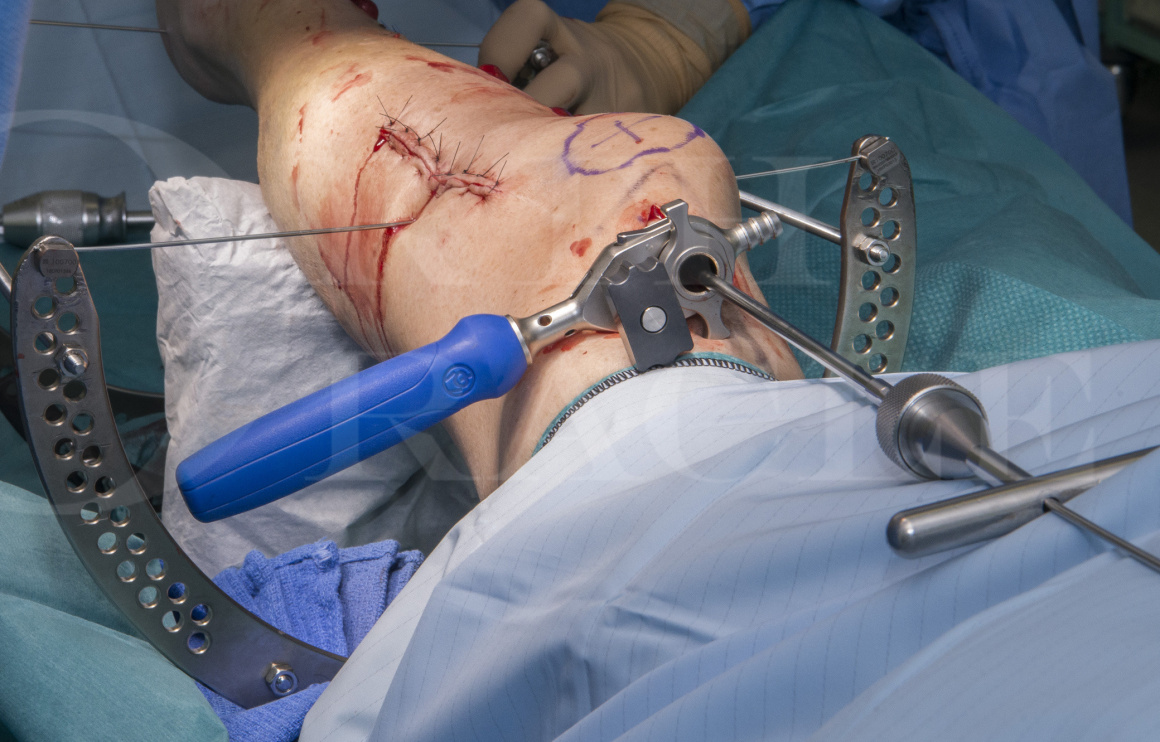Distal tibial fracture managed with fixator assisted Synthes Expert tibial nail with supra-patella nail approach and blocking screw
Overview

Subscribe to get full access to this operation and the extensive Knee Surgery Atlas.
Watch the overview
Learn the Distal tibial fracture managed with fixator assisted Synthes Expert tibial nail with supra-patella nail approach and blocking screw surgical technique with step by step instructions on OrthOracle. Our e-learning platform contains high resolution images and a certified CME of the Distal tibial fracture managed with fixator assisted Synthes Expert tibial nail with supra-patella nail approach and blocking screw surgical procedure.
Fractures of the distal tibia can be challenging to manage. There is often a poor soft tissue envelope predisposing to soft tissue complications with open techniques such as internal fixation with plates. The bone in this region has a poor blood supply, which can lead to delayed or non-union. A high proportion of these injuries extend to involve the tibial plafond although this extension is often not apparent on plain radiographs and in our unit we routinely perform CT scans to exclude occult intra-articular extension in distal 1/3 tibia fractures.
Surgical stabilisation can be achieved in a number of ways. Internal fixation with plates may be indicated with fractures which extend close to, or involve, the ankle joint. In patients with severely injured soft tissues ring fixators may be used to minimise the surgical insult to the soft tissues.
Locked intramedullary nailing is an established fixation technique for diaphyseal tibial fractures with good reported results. Newer generation nails with increased proximal and distal locking screw options, including multi-plane locking screws, have increased the indications for tibial nails to include metaphyseal fractures. Krettek described the use of blocking, or Poller, screws to augment stability with intra-medullary nailing and to extend the indications for nailing to include metaphyseal fractures (1.). The technique he described involved placing screws on the concave side of the deformity. He used solid, unreamed, nails and placed the screws just before the nail was passed across a segment. As the nail passes and engages with the blocking screw the nail is guided to a central position in the bone and fracture alignment is controlled.
With newer generation, reamed, nails the use of blocking screws has evolved. They can be inserted either prior to reaming to control the reaming rod or prior to nail insertion. The Poller effect can be achieved with a screw or with a k-wire, the use of wires has the advantage of being easier to adjust the wire position does not achieve the desired effect. Here I describe fixation of a distal tibia fracture with intra-articular extension using the Synthes expert tibia nail, inserted via a supra-patella approach, and the use of blocking screws to control the fracture alignment. The expert tibia nail can be inserted via standard infra-patella approaches or via a supra-patella approach using the relevant instrumentation. It has multiple locking screw options, in multiple planes, both distally and proximally allowing it to be used to fix metaphyseal fractures at both ends of the tibia.
- C Krettek 1 , C Stephan, P Schandelmaier, M Richter, H C Pape, T Miclau. The use of Poller screws as blocking screws in stabilising tibial fractures treated with small diameter intramedullary nails. Bone Joint Surg Br. 1999 Nov;81(6):963-8. doi: 10.1302/0301-620x.81b6.10000.
Author: Paul Fenton FRCS (Tr & Orth)
Institution: The Queen Elizabeth Hospital, Birmingham, UK.
Clinicians should seek clarification on whether any implant demonstrated is licensed for use in their own country.
In the USA contact: fda.gov
In the UK contact: gov.uk
In the EU contact: ema.europa.eu



















